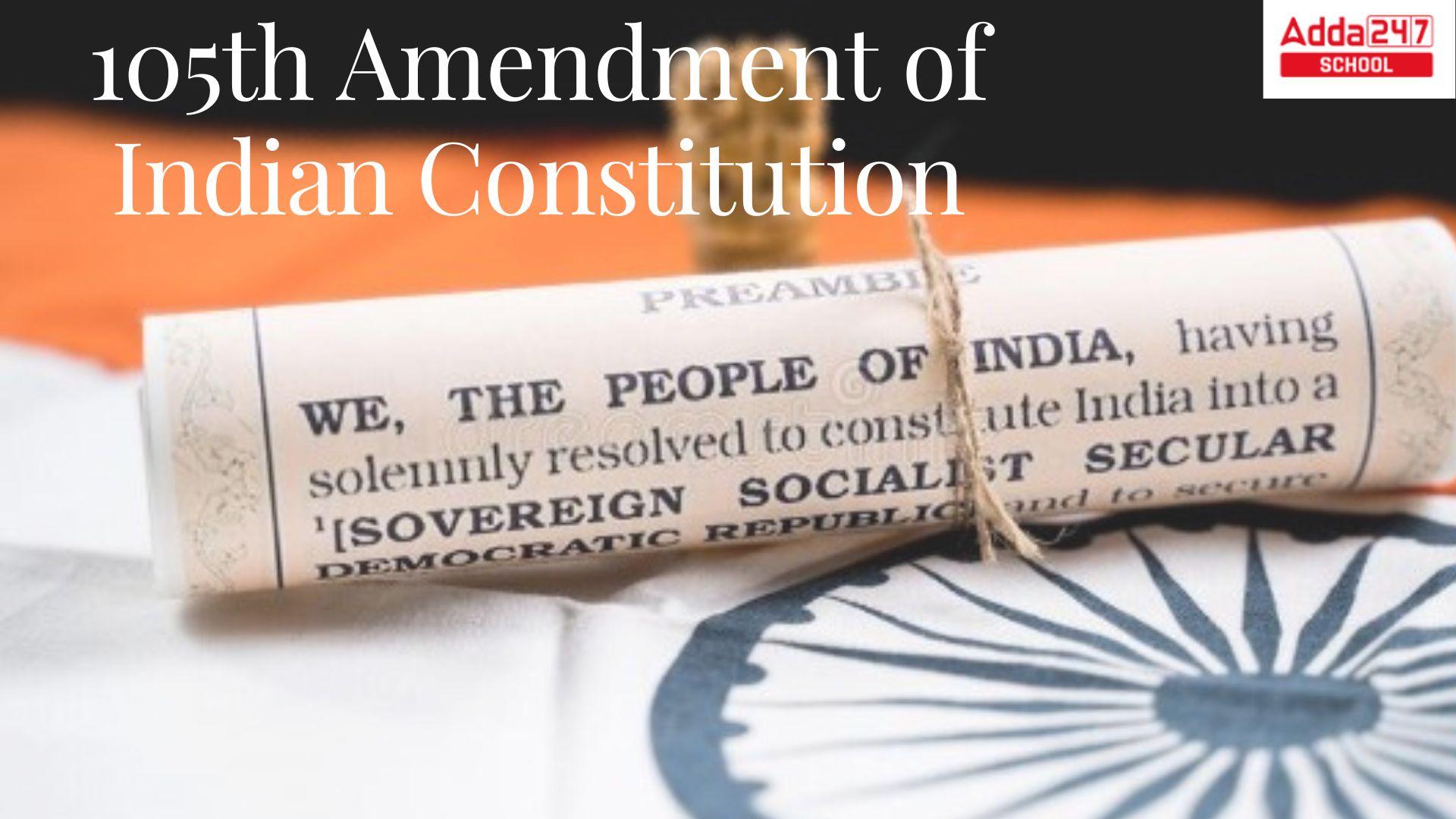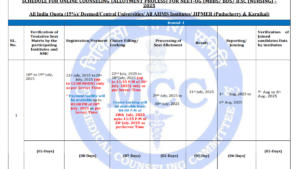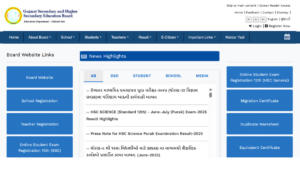105 Amendment of Indian Constitution
The 105 Amendment of Indian Constitution was notified on August 19 after receiving the acquiescence of then-President Ramnath Kovind. The 105 Constitutional Amendment Act aims to give states the authority to identify socially and educationally backward classes. The 105th Amendment of Indian Constitution was required to correct the impact of a Supreme Court ruling that States had lost their ability to include or exclude communities from the ‘Backward Classes’ list after Parliament passed the 102nd Constitution Amendment.
105 Constitutional Amendment Act
The latest amendment to the Indian Constitution 2021 is the 105 Constitutional Amendment Act, 2021. The 105th Amendment Bill is aimed at restoring state governments’ ability to identify OBCs who are socially and educationally backward. The 105th Amendment of Indian Constitution will change clauses 1 and 2 of Article 342A and add a new clause 3. Articles 366 (26c) and 338B will also be amended by this bill. It is meant to make sure that states can keep the “state list” of OBCs. It’s better to mention here that the purpose of the 102nd amendment was to establish a Central List that would be used only by the Central Government and its organizations. It had nothing to do with the State Lists of Weaker Sections or the powers of the State governments to proclaim a community backward.
Important Articles of Indian Constitution
Latest Amendment of the Indian Constitution (105th)- Reasons
Just a month after the 102nd Amendment was passed, The Maharashtra government’s law granting the Maratha’s Communally and Economically Backward Classes position was overturned by the Supreme Court, and the Supreme Court, for the first time, retained that the 102nd Amendment had taken away States’ powers to recognize SEBCs.
In the Jaishri Laxmanrao Patil v. Chief Minister of Maharashtra case, the Supreme Court issued its decision in May 2021. In November 2018, the Maharashtra state assembly passed legislation designating Marathas as SEBC and granting them preference in higher education and public employment. The statute was challenged, among other things, because the 102nd Constitutional Amendment eliminated the state’s authority to recognize SEBCs. The Court agreed and reversed the rule by a 3:2 vote.
The majority believes that the text of the Constitution should be the primary guide for interpretation. As a result, the literal interpretation of the amended Constitution was used, despite parliamentary records indicating that no purpose was made to remove the States’ authority to recognize SEBCs.
The court’s decision stunned the political establishment. Many national and state parties supported the recovery of state authority. Because this verdict would result in the loss of SEBC status for many communities, the Union government instantly requested that the Court reassess its decision. On June 28, the court made a decision dismissing the appeal. The Union government introduced the 127th Constitutional Amendment Bill, which later became the 105th Constitutional Amendment Act, in August.
List of Amendments in Indian Constitution
105 Amendment of Indian Constitution Year
The 105th Amendment of Indian Constitution was imposed in the year 2021, The 127th Constitutional Amendment Bill included the 105th Amendment Act. Some of the significant highlights of the 105th Amendment of the Indian Constitution are discussed below.
- The Maharashtra government granted 16% reservation to the Maratha Quota in 2019, but the court overturned this decision for two reasons.
- It exceeded the reservation limit imposed in the landmark Indira Sawhney case.
- The second reason given by the Supreme Court was that the state lost its authority to grant OBC reservations under the 102nd amendment.
- The National Commission for Backward Classes (NCBC) accomplished constitutional status in 2018 through the 102nd Amendment Act, which noted that the President and Central Government will preserve the list of Backward Classes, which states ended up losing the power to maintain.
- The 105th amendment was then carried, rebuilding the state government’s authority to recognize Socially and Economically Backward Classes.
- The 102nd Amendment introduced Article 338 B and Article 342 A, in which Article 338B granted NCBC constitutional status and Article 342A granted the Central Government the authority to preserve the OBC list.
11 Fundamental Duties of Indian Constitution List For Indian Citizens
105th Amendment of Indian Constitution: Significance
The 105th Amendment of Indian Constitution Act of 2021 is the latest Amendment to our Constitution. It primarily focuses on restoring the state government’s authority to recognize Other Backward Classes (OBCs) who are socially and economically backward. The Act was passed on August 18, 2021, and its significance is addressed below.
- This 105th Amendment of Indian Constitution bill promotes social liberation.
- The goal of the 105 Constitutional Amendment Act, is to establish a Central List that will only be used by the Central Government and its institutions.
- Nothing to do with state lists of retarded classes or state governments’ authority to declare a community retarded.
- The bill will benefit approximately 671 OBC communities because they wouldn’t have full rights to reservations in places of business and academic institutions if the state list had been eradicated.
- Furthermore, it demonstrates our government’s commitment to ensuring the equality, opportunity, and integrity of underprivileged groups.
Schedules of Indian Constitution Trick
105 Constitutional Amendment Act: Impact
Noteworthy Impacts of 105 Constitutional Amendment Acts are briefly discussed below. The 105 Constitutional Amendment Act addressed the issue by amending Article 342A clauses 1 and 2 and adding a new clause, clause 3.
- The 105 Constitutional Amendment Act tackled the problem by modifying clauses 1 and 2 of Article 342A and adding clause 3. Articles 366 and 338B were also modified.
- The act regained the power of state governments to notify the morally and intellectually disadvantaged classes.
- For years, arguments for and against the provision of the constitutional reservation have raged.
- After several years of independence, we as a society are still attempting to create uniform privileges for our people as well as to eliminate prejudice and unequal treatment through reservation.
- The 105th Constitutional Amendment Act represents yet another attempt to achieve equality in society through federal equality.
- It has restored states’ rights to compile a list of the socially and educationally disadvantaged.
105th Amendment of Indian Constitution UPSC
The 105th Amendment of Indian Constitution UPSC is a critical topic in Current Affairs section. The 105th Constitutional amendment act is the latest amendment to the Constitution, which come into force in 2021. Basic NCERT books for UPSC and standard Books can be used to study the 105th Amendment of Indian Constitution and this Act is important for both the UPSC Prelims and Mains exams. The Supreme Court stated in May 2021 that the 102nd Constitutional Amendment of 2018 had given the State Government the authority to identify SEBCs. For many years, the States had this jurisdiction, and almost every regional and national party called for an amendment to restore power. In August 2021, the Lok Sabha and Rajya Sabha Houses introduced and authorized the bill in three days.
105th Amendment of Indian Constitution: Preparation for CUET PG and Law Exams
Below is the video of the Important Amendments of the Indian Constitution for the Preparation of CUET PG, DULLB 2023, CLAT 2024, AILET 2024 and MHCET Law:
Constitution of India: Video for CUET PG Preparation
Below is the video of Constitution of India for CUET PG, DULLB 2023, CLAT 2024, AILET 2024, and other Exams:
Constitution of India: Video for Law Preparation
Below is the Video of Constitution of India Part 1, for Preparation of Law Exams like DULLB 2023, AILET 2024, CLAT 2024, and MHCET Law:
Below is the Video of Constitution of India Part 2, for Preparation of Law Exams like DULLB 2023, AILET 2024, CLAT 2024, and MHCET Law:









 NEET UG 2025 Counselling Dates OUT! Chec...
NEET UG 2025 Counselling Dates OUT! Chec...
 Dr MGR Medical University Results 2025 R...
Dr MGR Medical University Results 2025 R...
 GSEB HSC Science Supply Result 2025 Down...
GSEB HSC Science Supply Result 2025 Down...









